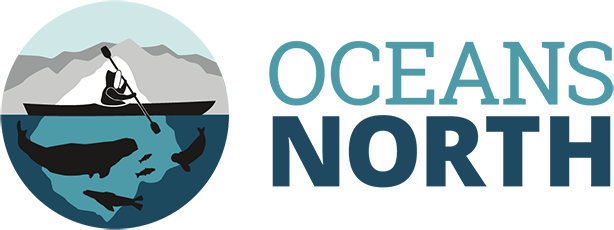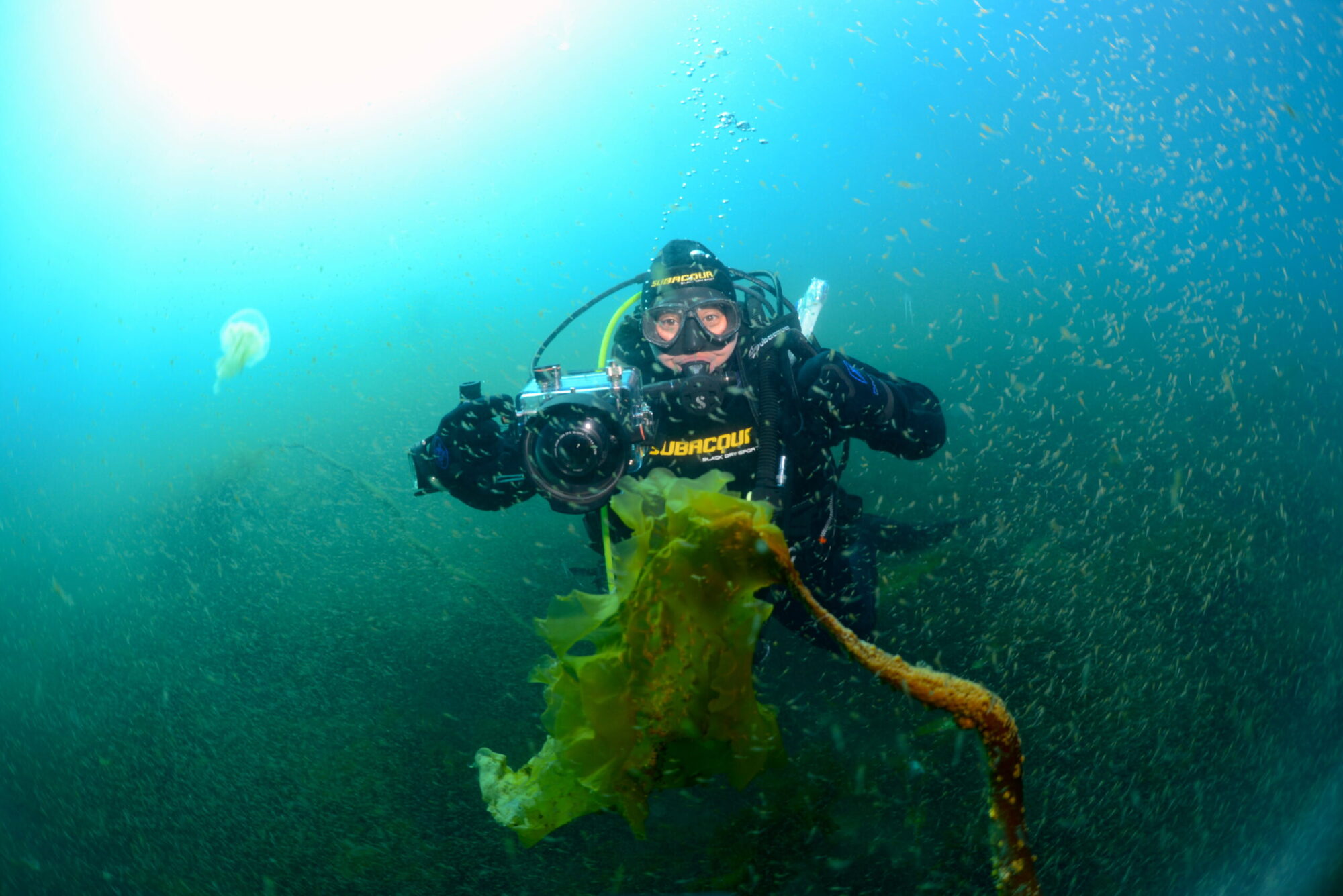
A Deeper Dive into Arctic Kelp
Credit – Ignacio Garrido
A Deeper Dive into Arctic Kelp
Colleen Turlo | July 19, 2023
In 2018, Oceans North published Canada’s Arctic Marine Atlas in partnership with Ducks Unlimited Canada and World Wildlife Fund Canada. This comprehensive atlas is a valuable resource that features oceanographic properties, human use, and Arctic species from the entire food web.
Kelp can be found throughout the world’s oceans, and it plays an important role in storing carbon and supporting marine biodiversity. At the time of publication, there was little information on kelp in the Arctic. Since then, however, researchers have learned more and documented kelp throughout the Eastern Arctic, where it’s a food source for coastal communities and a key habitat for many species. Here we introduce some of what they have learned and showcase Arctic kelp, one of the newest additions to our Arctic Marine Atlas.

Image – An isopod (Saduria entomon) rests on some Arctic suction-cup kelp (Laminaria solidungula) while a diver from ArcticKelp collects small kelp samples and records observations.
Credit – Ignacio Garrido
Kelp 101
Kelp are made up of three parts: Blades, stripes, and holdfasts. Blades (like the leaves of a tree) turn sunlight into energy; stipes (like tree trunks) keep blades raised in the water column; and holdfasts (like roots) secure the kelp to the seafloor. Some species of kelp also have gas-filled bladders that allow them to float.
Kelp can grow together over large areas to form kelp forests. Like forests on land, kelp absorb carbon dioxide, but they get nutrients from the ocean instead of the soil. Since kelp need nutrients such as nitrogen and phosphorus to grow and survive, its presence can be an indication that an area is rich in nutrients. For fish and many other marine species, kelp is a source of food and creates important habitat like nursery grounds and places of shelter.
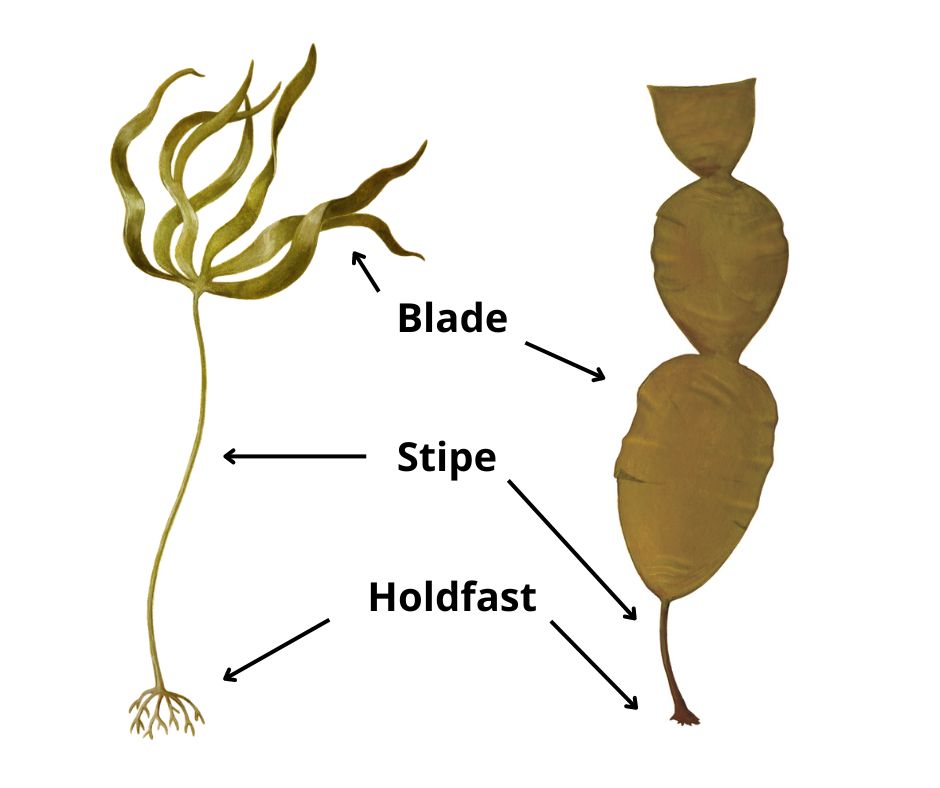
Image – A diagram of the elements of kelp. Left: Laminaria hyperborea | Right: Laminaria solidungula
Credit – ArcticKelp
Kelp in the Arctic
Kelp grows in coastal areas as it needs sunlight. In the Eastern Canadian Arctic, kelp covers over 300,000 square kilometres and can commonly be found at depths of 5–40 metres.
Arctic kelp is unique in many ways. Firstly, it can be found on a variety of surfaces, such as rock, pebbles, sand, and even on boulders. Additionally, kelp in the Arctic has had to adapt in order to survive long periods with no sunlight. During the winter months, much of the Arctic does not see the sun (a phenomenon called polar night) and the ocean is covered by ice.
There are four main types of kelp that grow in the Arctic: sea colander kelp (Agarum clathratum); winged kelp (Alaria escultenta); sugar kelp (Saccharina latissima); and Arctic suction-cup kelp (Laminaria solidungula). Through new field sampling, historical museum records, and past research, a first-of-its-kind map has been created by ArcticKelp researchers to identify where different species of Arctic kelp can be found.
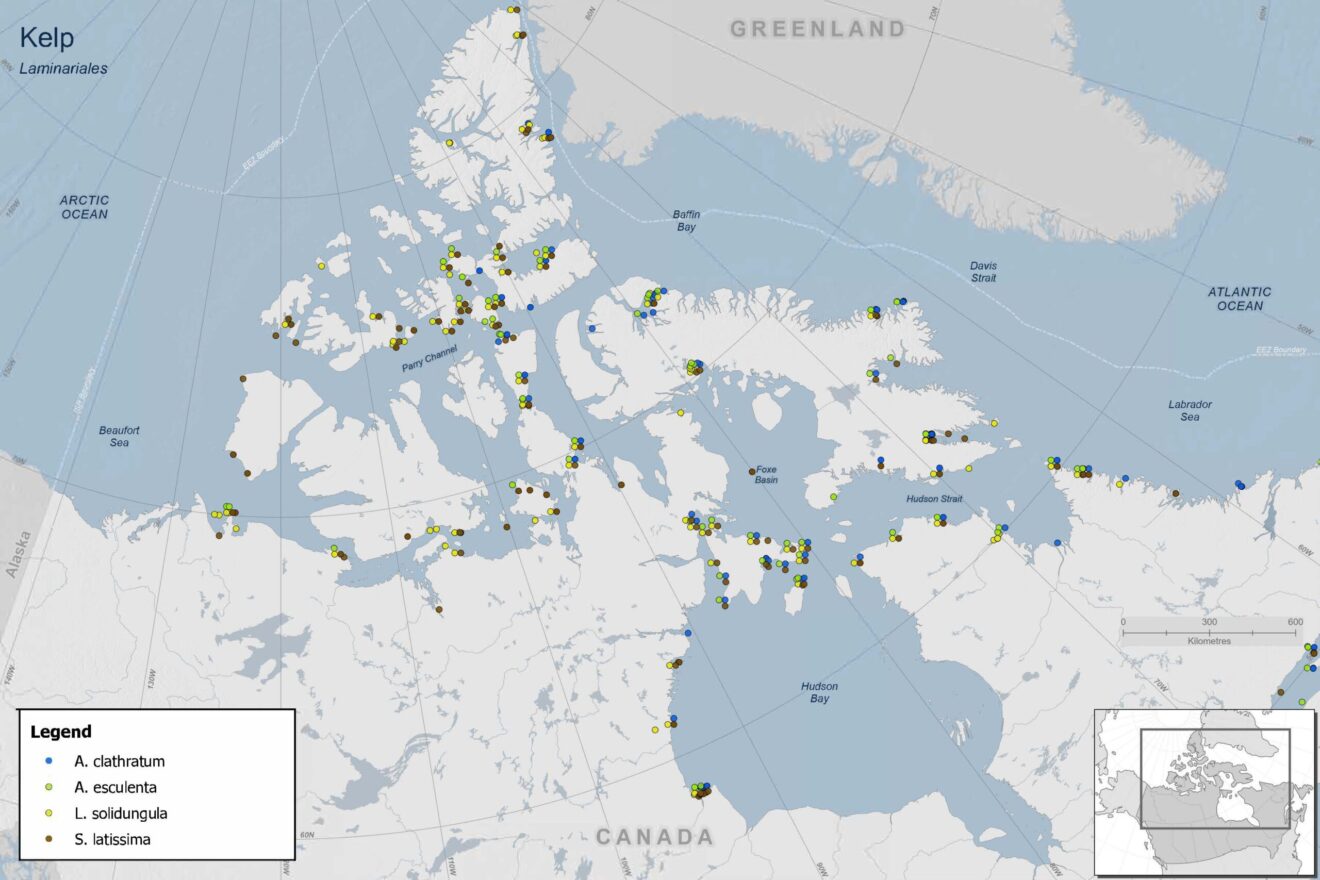
Image – A map created by ArcticKelp researchers to identify where different species of Arctic kelp can be found.
While the map shows where Arctic kelp has been found so far, it is not complete. Any sparse areas on the map are more likely to reflect a lack of data rather than the absence of kelp. Most kelp forests have been recorded through diving studies and underwater cameras, which limits studies to human-accessible areas. This makes tracking long term changes from climate change difficult, as we are still just learning about these kelp forests and the benefits they provide. For instance, a new study from Simon Fraser University has suggested that kelp forests may help reduce underwater noise from ships, providing a quiet refuge for marine species!
Community Use
Understanding how climate change will affect Arctic kelp is also important for many communities across the Arctic. Winged kelp and Arctic suction-cup kelp are a nutritious food and provide a good source of calcium, copper, and chromium. Kelp can be eaten fresh, dried, or cooked.
We asked some people to share their experiences and memories of kelp with us. Elizabeth Aiyout from Talurjuaq (Taloyoak), Nunavut, says:
“My late mother-in-law boiled it in her seal meat soup. It was very tasty. I believe we had to collect it north of Taloyoak, along Boothia Peninsula. Rhoda Nanook, an elder from my community, told me that when her mom used to cook seal meat, or whatever she cooked, she’d give a piece of seaweed (Quanniq) to them and they would dip it in the broth and eat it. Or sometimes they would just dip it in hot water and eat it too.”
Elder Jimmy Haniliak from Cambridge Bay tasted seaweed in Iqaluit, but says it was not really a part of his diet living in Cambridge Bay because it wasn’t found near the community. When on the land he did notice that caribou would eat it. He observed caribou migrating from the mainland to the island (Victoria Island). “As soon as they get to the shoreline, they start eating the dried seaweed on the shore,” he says.
To see some underwater kelp footage and learn more about what is and isn’t edible, take a look at this new video called “Can I Eat It,” created by ArcticKelp and filmed in Cambridge Bay, Nunavut.
Q&A With a Kelp Scientist
Camille Lavoie is a PhD student at Laval University and is involved in the ArcticKelp project, which is supported in part by Oceans North. We asked Camille to answer some of our remaining kelp questions.
Why is it important to study kelp in the Arctic?
The Arctic is vast and scientists are just starting to understand the different processes that shape its coastal seascapes. We know that kelp forests are important ecosystems in other parts of the world, and we want to know more about their different roles in polar habitats, especially in the context of global warming.
Of course, “the Arctic” is in fact a mosaic of regions with their own oceanographic conditions. Gathering both empirical and quantitative knowledge about kelp in these different places gives us a base to think about how things might change over time. It can also reveal areas of richness we should seek to protect. For example, our team has provided detailed knowledge about kelp around Southampton Island to Fisheries and Oceans Canada, which is considering whether these waters will become a Marine Protected Area.
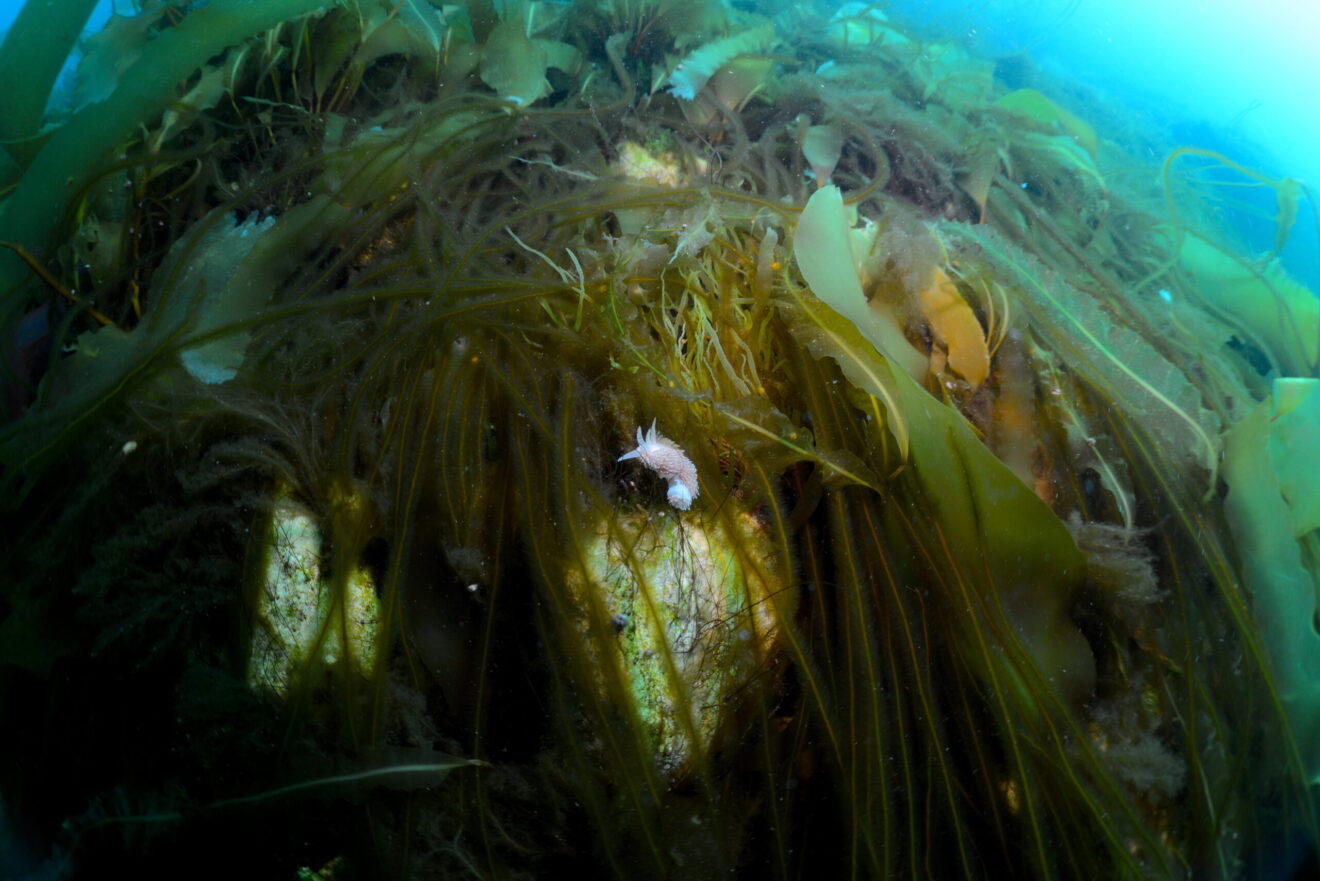
Image – A nudibranch (Ziminella sp.) on mixed winged kelp (Corda, Alaria esculenta) and sugar kelp (Saccharina latissima) just west of Southampton Island.
Credit – Ignacio Garrido
What new findings or discoveries have you made in the past couple years?
In most of the Arctic, kelp is doing very well. However, warmer waters down south seem to increase grazing activity by sea urchins, while ice and low light very far north mean fewer opportunities for photosynthesis or substrate colonization.
We have also built a model for the distribution of different kelp species in the Eastern Arctic. We were able to determine that as much as 312,000 km2 is covered with kelp. That means about 9 percent of the world’s known kelp is found in the Eastern Arctic! This model also shows that the general kelp coverage should expand until 2050 and that some species might outcompete others. Another surprise was how much deeper kelp can grow in the Arctic compared to temperate regions. Outside the Arctic, kelp is rarely found more than 20 metres deep, but the Arctic’s clear waters mean kelp can grow at depths of 40-50 metres.
What can kelp tell us about our marine ecosystem?
Kelp presence is generally a sign of healthy shores. Kelp takes a while to reproduce, so dense and extensive kelp forests are more likely to be found in undisturbed areas— spared by waves, fisheries or sea urchins. Many invertebrates and fish species also spend their juvenile or larval stages in shallow kelp forests where they can hide and feed, meaning kelp act as faunal reservoirs that refill adjacent deep or pelagic habitats and sustain fisheries.
For more information on Arctic kelp, check out the updated Arctic Marine Atlas.
Colleen Turlo is a policy advisor at Oceans North.
